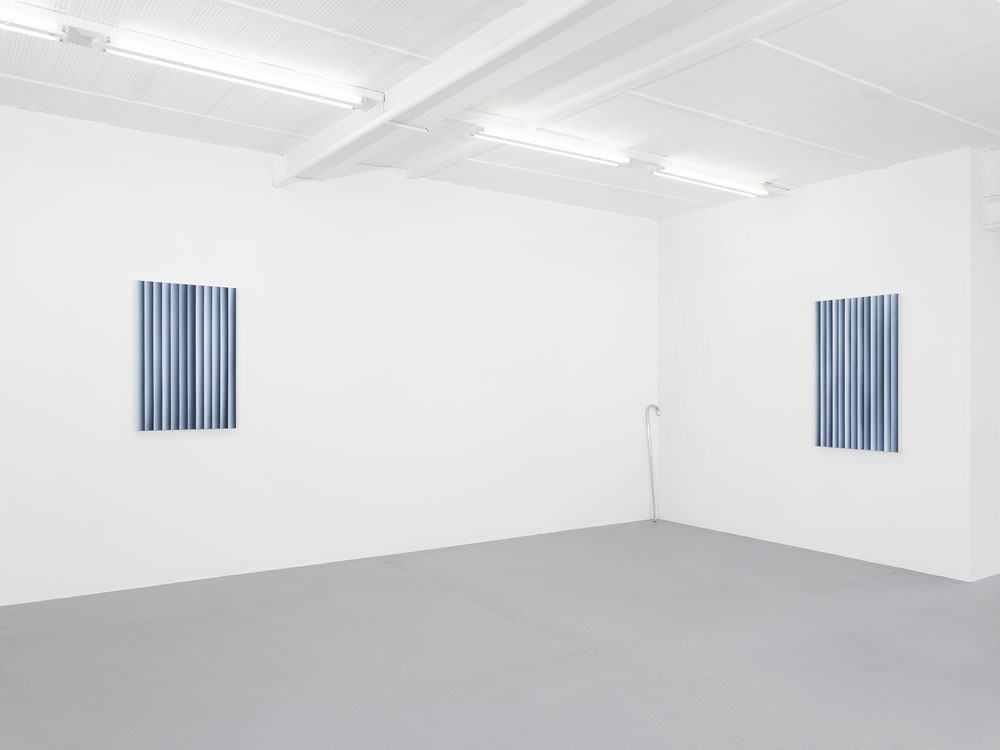Philippe Decrauzat: Blind Paintings 10 February—25 March 2023
Views

|

|

|

|

|

|

|

|

|
66,5 x 50 cm

|
90 x 60 cm

|
90 x 60 cm

|
110 x 65 cm
-
Exhibitions view
-
Exhibition view
-
Exhibition view
-
Exhibition view
-
Exhibitions view
-
Exhibition view
Text
Vision and its effects are always inseparable from the possibilities of an observing subject who is both the historical product and the site of certain practices, techniques, institutions, and procedures of subjectification.
– Jonathan Crary
In Techniques of the Observer: Vision and Modernity in the Nineteenth Century (1990), Crary argues that vision is not limited to what the human eye perceives of the external world, and no one can claim to see the world in transparent clarity. Our ways of seeing are continuously (re)produced from conventions or devices that, in a given time or situation, favor the emergence of certain faculties of observation at the expense of others. Philippe Decrauzat’s work is crossed by this desire to explore the unstable territory of vision. Each exhibition constitutes a program that invites us to observe the relationships, tensions and impulses that are established between the visible and the invisible.
With Blind Paintings, he presents a series of new paintings that open a new chapter in his meticulous investigation. All the paintings are composed of vertical strips of gradations, from white to black, juxtaposed to each other, with blurred effects and sharp transitions.
Vision and its effects are always inseparable from the possibilities of an observing subject who is both the historical product and the site of certain practices, techniques, institutions, and procedures of subjectification.
– Jonathan Crary
In Techniques of the Observer: Vision and Modernity in the Nineteenth Century (1990), Crary argues that vision is not limited to what the human eye perceives of the external world, and no one can claim to see the world in transparent clarity. Our ways of seeing are continuously (re)produced from conventions or devices that, in a given time or situation, favor the emergence of certain faculties of observation at the expense of others. Philippe Decrauzat’s work is crossed by this desire to explore the unstable territory of vision. Each exhibition constitutes a program that invites us to observe the relationships, tensions and impulses that are established between the visible and the invisible.
With Blind Paintings, he presents a series of new paintings that open a new chapter in his meticulous investigation. All the paintings are composed of vertical strips of gradations, from white to black, juxtaposed to each other, with blurred effects and sharp transitions. Part of the process of composition of the canvas is carried out “blindly”, which introduces a part of randomness. The effects of variations in shading, rhythm, or ripples are infinite. Each painting is unique and a more careful attention reveals some traces of brushes and the texture of the flat areas. The gaze is totally absorbed by the materiality and the seriality of these gradations.
The title of this series also refers to the particular framings and experiences that these paintings introduce into the exhibition space. Over the centuries, particularly since linear perspective, the window has provided a device and metaphor for evoking a direct and unbiased representation of reality. The “blind” or Venetian window is a device to protect oneself or to regulate the sun’s rays. It also acts as a filter which, by allowing to look without being seen, operates a setting at distance or a retrenchment. Decrauzat reverses the motif of the blind and the Blind Paintings are windows that close off the junction between the interior and exterior of the exhibition space. The eye has nothing to see beyond the canvas and the opacity of the calibrating operations replaces the clarity of transparency.
The paintings in this series act as interfaces that, between two blinks of the eye, sample all the potentialities of an observation situation.
Joël Vacheron
